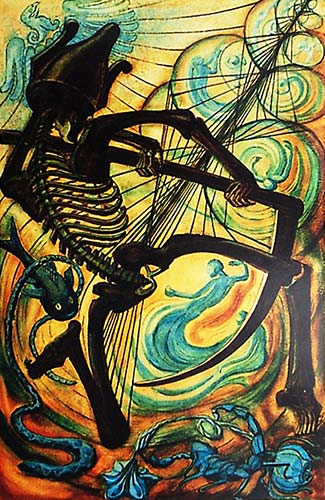XIII

Death
The Universe is Change;
every Change is the
effect of an Act of Love; all
Acts of Love
contain Pure Joy. Die daily.
Death is the apex of one
curve of the snake Life:
behold all Opposites as
necessary complements,
and rejoice.
Transformation, change, voluntary or involuntary, in either case logical development of existing conditions, yet perhaps sudden and unexpected. Apparent death or destruction, but such interpretation is illusion.
This card is attributed to the letter Nun, which means a fish; the symbol of life beneath the waters; life travelling through the waters. It refers to the Zodiacal sign of Scorpio, which is ruled by Mars, the planet of fiery energy in its lowest form, which is therefore necessary to provide the impulse. In alchemy, this card explains the idea of putrefaction, the technical name given by its adepts to the series of chemical changes which develops the final form of life from the original latent seed in the Orphic egg.
This sign is one of the two most powerful in the Zodiac, but it has not the simplicity and intensity of Leo. It is formally divided into three parts; the lowest is symbolized by the Scorpion, which was supposed by early observers of Nature to commit suicide when finding itself ringed with fire, or otherwise in a desperate situation. This represents putrefaction in its lowest form. The strain of environment has become intolerable, and the attacked element willingly subjects itself to change; thus, potassium thrown upon water becomes ignited, and accepts the embrace of the hydroxyl radicle.
The middle interpretation of this sign is given by the serpent, who is, moreover, the main theme of the sign.1 The serpent is sacred, Lord of Life and Death, and its method of progression suggests the rhythmical undulation of those twin phases of life which we Call respectively life and death. The serpent is also, as previously explained, the principal symbol of male energy. From this it will be seen that this card is, in a very strict sense, the completion of the card called Lust, Atu XI, and Atu XII represents the solution or dissolution which links them.
The highest aspect of the card is the Eagle, which represents exaltation above solid matter. It was understood by the early chemists that, in certain experiments, the purest (i.e., most tenuous) elements present were given off as gas or vapour. There are thus represented in this card the three essential types of putrefaction.
The card itself represents the dance of death; the figure is a skeleton bearing a scythe, and both the skeleton and the scythe are importantly Saturnian symbols. This appears strange, as Saturn has no overt connection with Scorpio; but Saturn represents the essential structure of existing things. He is that elemental nature of things which is not destroyed by the ordinary changes which occur in the operations of Nature. Furthermore, he is crowned with the crown of Osiris; he represents Osiris in the waters of Amennti. Yet more, he is the original secret male creative God: see Atu XV. “Redeunt Saturnia regna.” It was only the corruption of the Tradition, the confusion with Set, and the Cult of the Dying God, misunderstood, deformed and distorted by the Black Lodge, that turned him into a senile and fiendish symbol.
1 The Qabalists embodied in the Book of Genesis, Caps I and II, this doctrine of regeneration. NChSh, the Serpent in Eden, has the value 358: 50 also MShICh, Messiah. He is, accordingly, in the secret doctrine, the Redeemer. The thesis may be developed at great length. Later in the Legend, the doctrine reappears in slightly different symbolism as the story of the Flood, elsewhere in this Essay explained. Of course, the Fish is identical in essence with the Serpent; for Fish=NVN=Scorpio=Serpent. Also, Teth, the letter of Leo, means Serpent. But Fish is also the Vesica, or Womb, and Christ~and so on. This symbol resumes the whole Secret Doctrine.
With the sweep of his scythe he creates bubbles in which are beginning to take shape the new forms which he creates in his dance; and these forms dance also.
In this card the symbol of the fish is paramount; the fish (Il pesce, as they call him in Naples and many other places) and the serpent are the two principal objects of worship in cults which taught the doctrines of resurrection or re-incarnation. Thus we have Oannes and Dagon, fish gods, in western Asia; in many other parts of the world are similar cults. Even in Christianity, Christ was represented as a fish. The Greek work IXThUS, “which means fish And very aptly symbolizes Christ”, as Browning reminds one, was supposed to be a notariqon, the initials of a sentence meaning “Jesus Christ Son of God, Saviour”. Nor is it an accident that St. Peter was a fisherman. The Gospels, too, are full of miracles involving fish, and the fish is sacred to Mercury, because of its cold-bloodedness, its swiftness and its brilliance. There is moreover the sexual symbolism. This again recalls the function of Mercury as the guide of the dead, and as the continuing elastic element in nature.
This card must then be considered as of greater importance and catholicity than would be expected from the plain Zodiacal attribution. It is even a compendium of universal energy in its most secret form.